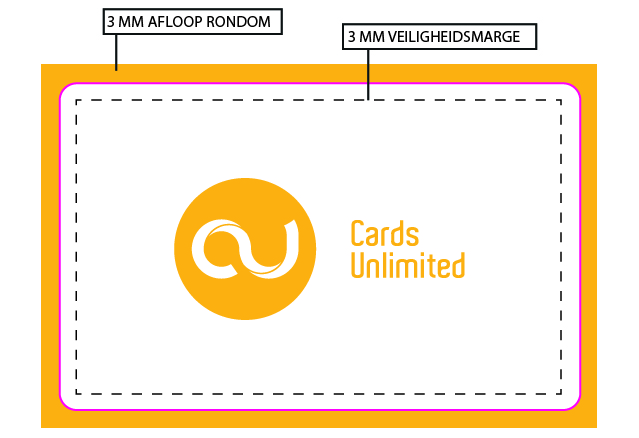Points to bear in mind for plastic card files:
- Finished card size is 53.9 x 85.7 mm
- Always check that all artwork/images are embedded in the file to avoid problems when opening.
- If you are delivering several files by e-mail use a programme like WinRar or Zip to compress them. You can also send your files via WeTransfer.
- Image resolution: 600 dpi. (At least 300 dpi).
- Text resolution: if you are unable to supply it as a vector object, please supply it in high resolution of at least 600 dpi.
- Embed, supply or convert fonts to letter outlines.
- Open file (eg. InDesign package or Illustrator): provide all associated images and fonts.
- Supporting colours: use the Pantone name.
- Floated images with 3 mm float on all sides.
- Do not cut a magnetic strip (if there is one) into the design.
- Rounded corners: 3 mm cross-section. We wil apply this automatically; you not need to add this to the file.
- Black text: define as 100% process black (in overprint). So do not build it up.
- In the case of a PDF: put everything in a single layer and do not leave any invisible or unprintable layers in the file.
Plastic card dimensions
The format of plastic cards is 53.9 x 85.7 mm. This format is determined by ISO standard: ISO/IEC 7810:2003 ID-1. The rounded corners are 3 mm in diameter. You do not need to add these to the design. Always create the design with an additional 3 mm round the edge. This allows us to make a perfectly beveled plastic pass.
Necessary free space for personalisation
The space needed for personalisation depends on various factors. Barcode type, length of name and address details, etc. We always agree with you on the space needed before the start of the printing process. Please find a few common cutouts below.
• Minimal cutout Intersolve barcode : 75 x 16mm
• Minimal cutout 123TCS barcode : 85 x 20mm
• Pincode cutout: 11 x 4mm (only applicable on dark background)
• Standard format scratch-off label : 19 x 6mm (other scratch-off label formats can be agreed)

